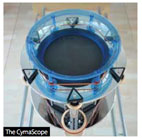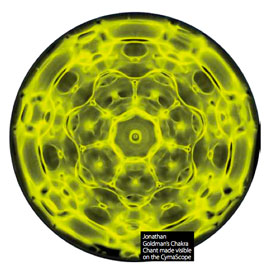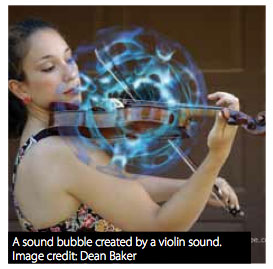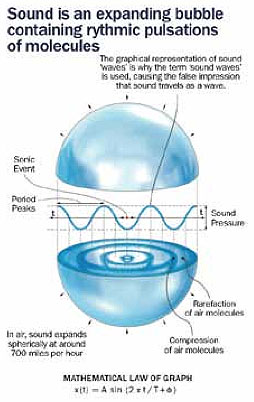Seeing Sound
Seeing Sound with the CymaScope
Sound is an invisible force that permeates every aspect of our lives. With the exception of music, many man- made sounds are jarring while the sounds of Nature tend to flow over and around us like soothing waters, lifting our spirit, inspiring us, exciting us. Yet if we could see sound our world would be even more beautiful than we could imagine. It would be a world filled with shimmering holographic bubbles, each displaying a kaleidoscopic pattern on its surface. To see sound is to open a new window onto our world, one that has been veiled in mystery until recently.
 When the microscope and telescope were invented centuries ago, new realms came into view that were not even suspected to exist—a Universe in miniature under the microscope and a Universe so immense that centuries of research lie before us with the telescope. Now, like the microscope and telescope that preceded it, the CymaScope instrument allows us to see a previously invisible realm—the world of sound— helping us to gain a deeper and fuller understanding of life and the Universe. The CymaScope uses the science of ‘cymatics’ to make sound visible, by imprinting sound’s invisible vibrations onto the surface of ultra pure water to reveal its once-hidden geometric structures.
When the microscope and telescope were invented centuries ago, new realms came into view that were not even suspected to exist—a Universe in miniature under the microscope and a Universe so immense that centuries of research lie before us with the telescope. Now, like the microscope and telescope that preceded it, the CymaScope instrument allows us to see a previously invisible realm—the world of sound— helping us to gain a deeper and fuller understanding of life and the Universe. The CymaScope uses the science of ‘cymatics’ to make sound visible, by imprinting sound’s invisible vibrations onto the surface of ultra pure water to reveal its once-hidden geometric structures.
 This new scientific frontier reveals aspects of Nature every bit as authentic as a flower or a butterfly, the stars in the heavens or starfish in the oceans—in fact, as we will come to see in this article, sound is just as much at work in the interior of a star as is in the organs of a starfish or in the cells of your body. Sound lies at the heart of every aspect of Nature, underpinning all of Creation. Cymatics will, in the future, enable humanity to understand far more about the Universe and our world than was possible with previous technologies. The CymaScope and the science of cymatics provide a bridge that will lead to significant advancements in knowledge.
This new scientific frontier reveals aspects of Nature every bit as authentic as a flower or a butterfly, the stars in the heavens or starfish in the oceans—in fact, as we will come to see in this article, sound is just as much at work in the interior of a star as is in the organs of a starfish or in the cells of your body. Sound lies at the heart of every aspect of Nature, underpinning all of Creation. Cymatics will, in the future, enable humanity to understand far more about the Universe and our world than was possible with previous technologies. The CymaScope and the science of cymatics provide a bridge that will lead to significant advancements in knowledge.
The Shape of Sound
Before looking at cymatics more closely let us dispel the popularly held misconception that ‘sound is a wave’. It isn’t. All audible sounds are, in fact, spherical in form or spheroidal, that is to say audible sounds are sphere-like but not necessarily perfectly spherical. For the sake of simplicity we’ll call these spheroidal sound spheres ‘sound bubbles.’
 Our world is teeming with beautiful holographic sound bubbles that envelop us in shimmering patterns of acoustic energy, each bubble rushing away at around 700 miles an hour as new bubbles form from the source of the sound. Whether the sound is emitted from your voice or from some other source, such as a musical instrument, this ‘bubble-in-a-hurry’ leaves a fleeting vibrational imprint on the surface of your body: every cell in the surface tissues of your body actually receives sound patterns from the bubbles that surround you. However, only low frequency sounds can penetrate the interior of your body. To understand more fully how your cells respond to the healing power of audible sounds please refer to our previous Veritas article, Rediscovering The Art And Science Of Sound Healing.
Our world is teeming with beautiful holographic sound bubbles that envelop us in shimmering patterns of acoustic energy, each bubble rushing away at around 700 miles an hour as new bubbles form from the source of the sound. Whether the sound is emitted from your voice or from some other source, such as a musical instrument, this ‘bubble-in-a-hurry’ leaves a fleeting vibrational imprint on the surface of your body: every cell in the surface tissues of your body actually receives sound patterns from the bubbles that surround you. However, only low frequency sounds can penetrate the interior of your body. To understand more fully how your cells respond to the healing power of audible sounds please refer to our previous Veritas article, Rediscovering The Art And Science Of Sound Healing.
Yet, despite the fact that sound is not a wave, the term ‘sound wave’ is in general use throughout the world, which is rather amazing when sound waves don’t actually exist! So let us briefly discuss how this strange anomaly has occurred.
 Sound is basically periodic movements of air molecules bumping into each other. These movements of sound can be described mathematically and when plotted graphically the shape of the graph does indeed look like a wave. However, if we could see audible sounds shimmering in the air around us we would see beautiful bubbles, not waves, so it is misleading to say that sound is a ‘wave.’ If what is actually a bubble is described as a wave it is possible that incorrect conclusions will be made about the way Nature works.
Sound is basically periodic movements of air molecules bumping into each other. These movements of sound can be described mathematically and when plotted graphically the shape of the graph does indeed look like a wave. However, if we could see audible sounds shimmering in the air around us we would see beautiful bubbles, not waves, so it is misleading to say that sound is a ‘wave.’ If what is actually a bubble is described as a wave it is possible that incorrect conclusions will be made about the way Nature works.
In the illustration below a slice through a sound bubble is depicted. The peaks of the graph represent the regions of high-pressure air within the sound bubble, whereas the mid points of the graph represent the areas of low-pressure air. The ‘space-form’ of audible sound is indeed bubble-like whereas the graph—often referred to as a sound wave—is merely a mathematical depiction of the peaks and valleys of sound pressure.
Sound and its Relationship with Light
To understand the concept of visual sound a little more fully it will be helpful to explore how the vibrating atoms of air that create sound relate to light and life. At the moment of these atomic sound collisions something quite magical happens: Light is created.
Light occurs every time the magnetic shells of two vibrating atoms bump against each other. The frequency of light created in this way depends on the energy in the collisions, meaning how fast they bump together. Try this experiment: Rub your hands vigorously together. You’ll feel warmth. This is because the atoms in one hand are slipping past the atoms in your other hand, creating heat, which is just another name for light. The light you create by this friction method is in the infrared part of the spectrum of electromagnetism, invisible to our eyes but quite visible to some species of bat, owl, snake and mosquito.
You create infrared light even when you speak. The atoms and molecules in the air are excited by the vocal folds in your larynx, creating a tiny pearl of acoustic energy that rapidly expands out of your mouth and rushes away at around 700 miles an hour. The atoms and molecules of air within this expanding bubble are bumping into each other, each collision transferring your voice vibrations to the nearest atom or molecule. As these ‘bumps’ occur they cause infrared light to be created due to the friction between the magnetic shells of the air particles. The infrared light carries with it the modulations of your voice that rush away at the incredible speed of 186,000 miles per second. Unlike the sound of a voice, which becomes inaudible after about one mile, the infrared light created by your voice rushes out into space where it travels for eternity, carrying your words or songs to the stars.
Thus, there is a direct relationship between sound and light and in fact there can be no light in the Universe without sound because light is only created when atoms collide with each other, and such collisions are sound. So light and life owe their existence to sound.
Content courtesy of John Stuart and Analiese Shandra Reid
Copyright (c) 2011. All Rights Reserved.
http://www.cymascope.com









